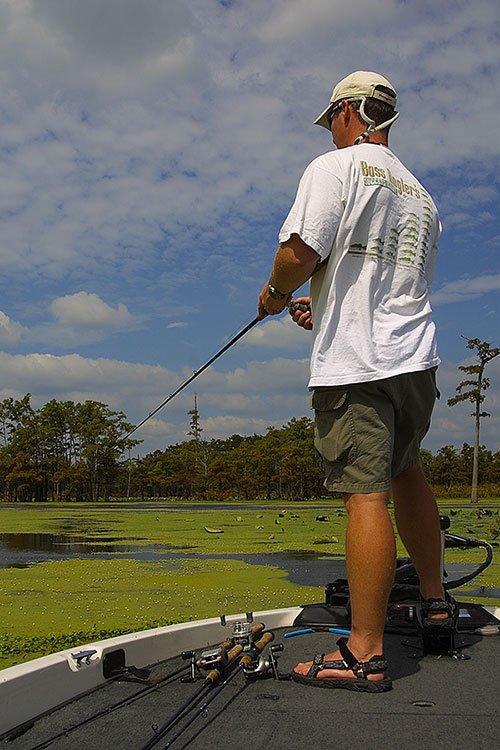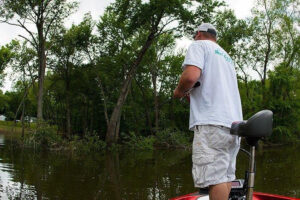Ever gone to a body of water and felt like finding bass was going to be like finding a needle in a stack of needles? That feeling comes over every angler now and again, especially when you’ve been toiling in a sea of seemingly similar cover without so much as a sniff. You start to lose your focus and lose sight of what it is you’re really searching for in a large area. It’s not just a bite but it’s those irregularities or regularities as the case may be that the fish are relating to.
We talked recently with Elite Series pro James Niggemeyer about how he dissects a field of standing timber and stumps and finds the few trees or areas that the bass are using in those big fields of cover. The same principles can be applied to grass, boat docks, laydowns and more.
While fishing in Northern Minnesota recently, we were able to use cover reading skills to quickly blow through fisheries and figure out how to catch better quality fish quickly. That for us is really where fishing gets fun. Sure it’s fun to set the hook and catch bass, but after we find a few fish, our minds start spinning calculations on other places like this where we might find more bass doing the same thing. Because duplicating what you find in one area in another is the essence of pattern fishing. What bait, what location and what type of cover are all part of the puzzle.
But reading cover is as much gut feeling sometimes as it is process of elimination. That’s because seeing where the fish are ambushing bait is only part of the puzzle. Knowing what bait they want to ambush is the other. So sifting through the cover and figuring out a few different baits that cover the water effectively can put you on the bass a lot faster.
With hotter than average temperatures through much of the country and low water levels on a lot of fisheries this spring, the grass and vegetation has come on like gang busters. Grass grass everywhere and not a blade to mow. Even if you don’t like to fish grass, it’s undeniable how much it helps a fishery even on those places that don’t have grass.
Pencil reeds, water willows, hydrilla, coontail, cabbage, milfoil, lily pads and more all offer the bass an ecosystem to hunt forage. Microorganisms, insects, larvae, shrimp, minnows, larger baitfish, bluegills, crawfish and more all make their home in vegetation and in turn draw predators closer.
Part of reading cover is breaking it into manageable pieces and attacking aspects of it so that when you do start getting bites, you can understand what you’ve found and apply it all over the fishery.
While on our trip to Minnesota, we were fishing on a small lake covered in pencil reeds and lily pads. It looked perfect for several baits and techniques. The grass for the most part was spread out and sporadic. But as we plowed through the fields throwing several different lures, I started to develop a pattern. The pencil reeds that clumped up and were a little thicker offered a hard target for a bass to lie behind.
I was throwing a swim jig and reeling it pretty fast to cover water quickly. The swim jig is a different sort of lure in that it draws strikes because of its speed as much as its looks. As I would fire it out over pencil reeds, as it drew in close to a cluster of reeds the line would snap tight and the fight had begun. We also started to find that if you could find where the pencil reeds pointed out or thinned closer to the bank you got strikes. Pencil reeds the furthest out in the lake also held fish. So it became easier and easier to pick your casts and target bass you couldn’t see like an eagle does.
In a perfect world it always works like that, but the truth is our bass in the south are extremely pressured. And pressure moves fish around. So identifying small nuances within the cover can be the key to finding bass. Do you hear or see the presence of food around the cover. Are there signs in the cover that bass have been feeding like bubbles, blow holes through mats, popping sounds of bluegills feeding under pads. All can be clues to feeding areas.
Same principles can be applied to manmade structure. You’ll start to figure out bass are on the up current side of a dock with the shade angling across it. Or they are on the back poles of a standing dock. Or they are only on the docks with a certain bottom or a certain depth. That makes breaking down the lake and the cover faster.
The biggest thing anglers have to learn is to not just go into cover laden areas and just blind cast around. Try to think of it as dissecting the area and every cast could be one that spooks a would be catch. So before you plow through the cover, work from the outside in. Look for irregularities and places where a bass could come out of hiding and attack forage.
Take a laydown for instance. If you go casting to the back of the log first, you run the risk of spooking the fish before you have a chance to catch it. Instead you can start on the outside limbs with quiet presentations and keep working into the cover and down the log. A lot of times multiple precise casts to a big laydown can yield limits of bass. Major tournaments have been won with this approach.
Look at every piece of cover or area covered in fish holding habitat as not random. The bass are there for a reason so target points in the grass, or pockets and cuts in the grass. Focus on making accurate quiet casts and letting your lures enter the strike zone without alarming the bass.
The more you can break down cover, the faster you can find and outsmart the bass. And in bass fishing, finding the best fish the fastest is often where the best memories are formed.












